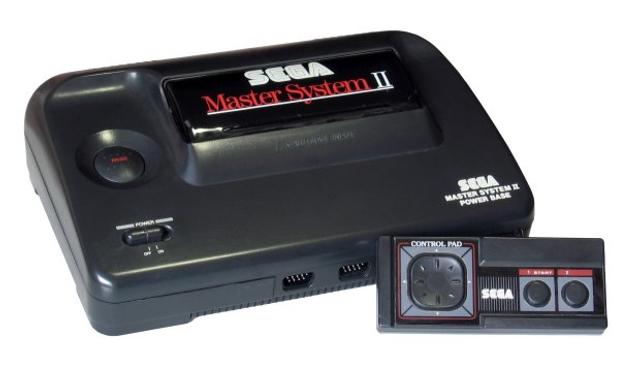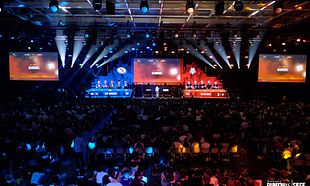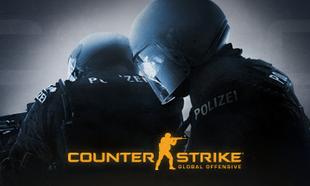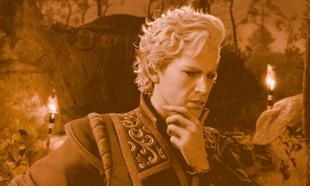When compared against the Nintendo Entertainment System, it's clear that Sega's 8-bit venture, the Master System, had little impact on the gaming landscape.
Despite a substantial library of games, many of which were arcade ports, the Master System went unnoticed by a large portion of the gaming public and didn't bring Sega into the popular consciousness in the same way that the NES did. Of course, it might have been down to the fact that its marketing strategy was non-existent and it only survived four years before the hugely superior Genesis / Mega-Drive was launched.
Still, for all these faults and bumps, the Master System wasn't without its charms.
Here's the ten best games for the venerable Sega Master System.
10. OPERATION WOLF
Believe it or not, the Master System did in fact have a light-gun similar to the Nintendo's Zapper. Whilst the Zapper looked more closer to a toy gun, the Master System's Phaser was sleek, black and looked a silenced pistol - which, of course, made it so much cooler. A direct port of an arcade smash, Operation Wolf saw players destroying richly designed pixels with the kind of accuracy reserved for Hot Shots! Part Deux. Loud, violent, somewhat buggy, Operation Wolf was everything you'd expect from early Master System games.
9. LAND OF ILLUSION STARRING MICKEY MOUSE
For whatever reason, Sonic the Hedgehog didn't port well to the Master System. It's possibly that the 8-bit system wasn't able to give you that same feeling of pure speed that you got from the Mega-Drive / Genesis version. What it did do well, however, was platform games and there's plenty of examples here on this list. It's hard to think of Mickey Mouse being a gaming character, but Land of Illusion and its predecessor, Castle of Illusion, were big successes for the Master System. As well as having well-designed graphics, the gameplay was suprisingly addictive and the cute soundtrack helped a lot.
8. WOLFCHILD
For every Mickey Mouse-esque game on the Master System, there was a weird, dark, violent game to balance it out. Wolfchild was one such game. You played a cybernetic werewolf who was trying to save his father from the clutches of an evil corporation bent on using his research for nefarious purposes. On paper, yes, it was pretty dull and yes, the gameplay did get a bit repetitive, but what made Wolfchild interesting was just how bleak and gritty it felt playing it. When compared to the cutesy, cuddly, warm and inviting nature of the NES, this was the antidote.
7. ZOOL
It's interesting that Zool was intended to be a direct competitor to Sonic the Hedgehog, even though it ended being ported to both the Sega Master System, Game Gear AND the Mega-Drive / Genesis upon its release. Why Zool was so good was because of just how smooth and sleak the game played. It's important to remember that, at that time, smoothness of the experience was a big draw. Anyone who played the Master System port of Mortal Kombat can tell you just how glitchy and unplayable it was. You kids don't know how good you have it with your 60 frames per second.
6. OLYMPIC GOLD BARCELONA '92
For whatever reason, sports games didn't really become an issue until the Super Nintendo and Konami's excellent International Super Star Soccer, which in turn became Pro Evo Soccer. There were a few exceptions, here and there, and Olympic Gold: Barcelona '92 was one such exception. With clear, well-made mechanics and a beautifully rendered graphics system, Barcelona '92 also perfected the mini-game system that the likes of California Games for the NES began. You had Archery, Sprint, Hammer Throw, High Jump, Diving (yeah, really) and Swimming - all in one game!
5. OUTRUN
Whether it was down to the graphics card or the fact that developers were more interested in longer form games, the Master System didn't do racing games all that much. Maybe it's because this and the next entry pretty much nailed the whole experience in one setting. OutRun put you right behind the wheel of a Ferrari Testarossa and the catchiest 8-bit soundtrack on your radio - WHICH YOU COULD CHANGE DURING RACES. As well as this, you also had a wildly changing background, driving from day to night and back again and the fact that you had a blonde lady as your passenger. Simpler times, really.
4. MICROMACHINES
Where OutRun had effortless cool with its Miami Vice-esque visuals, Micromachines was pure speed and dexterity with a controller. What you needed to play Micromachine was concentration. Reaction time was a factor and the fact that there were no clearly defined rules as to going in on and off track meant that if you were playing against someone, you had to be able to adapt. Playing on your own meant that it was about learning the layout of each track in advance. The fact that these tracks were actually people's dinner tables didn't really dawn on us. It was the early '90s - everything looked weird back then.
3. JAMES POND II: ROBOCOD
It's a real testament to the programming skills that James Pond II: Robocod looked so slick and graphically superior to almost any other game on the Master System. Also, the fact that you were a half-fish, half-Robocop inspired character helped a lot. Of course, if you were that age, there was no way you were supposed to know what Robocop was. Right? In a way, it's amazing. The makers behind this game knew that young kids were watching ridiculously violent films and decided to force a talking fish into that framework. Amazing, really. Oh, and one stage in the game saw you in a flying bathtub.
2. ALEX THE KIDD IN MIRACLE WORLD
If the Master System had become the success in the same vein as the NES and the Mega Drive / Genesis, Alex The Kidd would be the mascot of Sega, not Sonic The Hedgehog. As it turned out, Alex The Kidd and his weird, giant ears never transported to the 16-bit era and we're all the lesser for it. A platformer, sure, but it also had the added bonus of a Rock-Paper-Scissors minigame AND you got to drive a bike on the second level of the game. Super Mario Bros. and Sonic didn't have bikes. That counted for a lot back in 1990.
1. PHANTASY STAR
Back when we wrote a similar article about the Nintendo Entertainment System, a number of people asked why Final Fantasy was left off. The reason is simple - Final Fantasy doesn't hold a candle to Phantasy Star. The richness of the gameplay, the sheer level of detail and design, the all-engrossing story, the fact that it was sold for $80.00 at the time of its release - all of it. Phantasy Star was the closest the 8-bit gaming era came to replicating the kind of in-depth, immersive RPGs we take for granted today. Sure, Zelda was cute and had some memorable moments, but Phantasy Star was pushing the boundaries of what a game could be and how it could be played.









































































